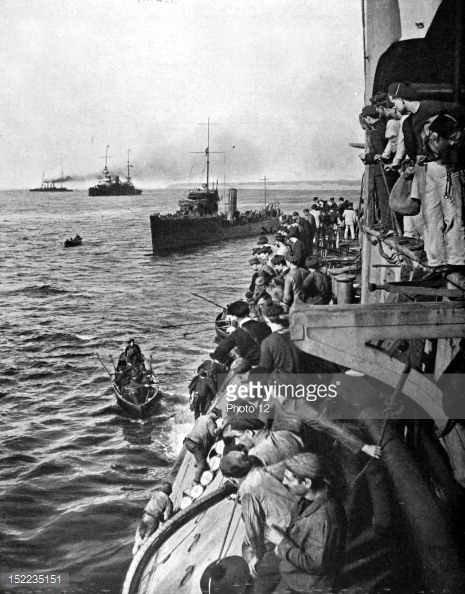At Dardanelles, Turkish Defenses Sink, Cripple Six Battleships;
A Colossal British Miscalculation
Special to The Great War Project
(17-18 March) On the morning of March 18th a century ago, the British unleash a huge naval attack on the Dardanelles, the strategic waterway in northwestern Turkey.
Initially ten battleships – six British and four French – take part as well as a fleet of minesweepers, cruisers, and destroyers. “Even in the long history of the Dardanelles,” writes war historian John Keegan, “such an armada had never been seen there before.”
At the start it looks bad for the Turks.
“The Turkish forts at the entrance to the straits had been put out of action by naval bombardment” in the days leading up to the allied assault, reports historian Martin Gilbert. Within three hours of the main assault, “the forts covering the minefields inside the straits had been incapacitated. The lines of mines laid across the entrance to the Dardanelles were swept clear as the warships advanced.”
There are nine more lines of mines that the British identify. “But,” writes Gilbert, “an unexpected line of twenty mines, which had been laid parallel to the shore by a small Turkish steamer, the Nousret, ten days earlier, wreaks havoc.”
“Minesweepers could not do their work because of gunfire from Ottoman forts,” writes historian Michael Neiberg. Many of the forts have German-trained gunners, and they prove highly effective.
Reports Gilbert, “three of the ten Allied battleships were sunk.” Another French ship is badly damaged and is beached. Another British ship hits a mine and is crippled.
More than 600 men on one of the French battleships drown.
The Germans advising the Turkish forces view this initial encounter with the world’s most powerful navy as a victory.
But the Turks are running out of ammunition, a circumstance the British and the French are not aware of.
“We’ve been very lucky,” comments one senior German officer on the scene. According to Gilbert, “His batteries had fired 1,600 rounds and scored 139 direct hits on the Allied warships. Only three of his men had been killed.”
The Turks construct dummy batteries with metal pipes pointed to the skies to deceive the Allied side.
Unexpectedly the Turks prove to be wily and determined adversaries, and they foil the British grand plan to force their way through the Dardanelles.
“The intention on March 18th was for the Anglo-French naval force to break through the narrows in the Sea of Marmara.” This would provide smooth sailing for the allies to attack Constantinople, the Ottoman capital.
Every member of the British War Council – Britain’s highest military and civilian leadership — expects “a swift push through the Dardanelles, followed by panic in the Turkish capital when so many warships appeared off its shoreline.”
It is a colossal British mistake.
Now the allies must revise their plans and do that quickly if they wish to salvage a most dangerous situation.
Winston Churchill, the First Lord of the Admiralty and the singular official who is most responsible for this operation, urges his colleagues on the War Council: give it one more day.
They do.


